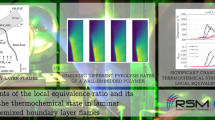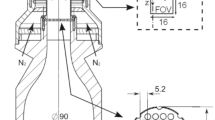Abstract
The presence of a turbulent premixed flame strongly influences the properties of the adjacent velocity boundary layer. This influence is studied here using a generic configuration where at atmospheric pressure turbulent premixed methane/air flames interact with a temperature stabilized wall. The experiment is optimized for well-defined boundary conditions and optical accessibility in the zone where the flame impinges at the wall. Laser based diagnostic methods are used to measure two components of the velocity field by particle image velocimetry simultaneously with the flame front position using laser induced fluorescence of the OH molecule. Two measurement planes are selected that are aligned perpendicularly to the surface of the wall. Based on this data, the flow field near the wall is analyzed by different methodologies using laboratory-fixed and flame-conditioned statistics, a quadrant splitting analysis of the Reynolds stresses and an evaluation of the production term of the turbulent kinetic energy. The results of chemically reactive cases are compared to their corresponding non-reactive flows for otherwise identical inflow conditions. In the zone of flame-wall interactions the boundary layer structure and its turbulence are dominated by the turbulent flame. Important features are that the flame compresses the boundary layer already upstream the location where the flame is finally quenched and that ejection and sweeps are no longer the dominant mechanisms as in non-reactive boundary layers. This experimental data may serve additionally as a database for model development for near wall reactive flows.










Similar content being viewed by others
References
Alkidas, A.C.: Combustion-chamber crevices: the major source of engine-out hydrocarbon emissions under fully warmed conditions. Prog. Energ. Combust. 25, 253–273 (1999)
Epstein, A.H.: Aircraft engines’ needs from combustion science and engineering. Combust. Flame 159, 1791–1792 (2012)
Dreizler, A., Böhm, B.: Advanced laser diagnostics for an improved understanding of premixed flame-wall interactions. Proc. Combust. Inst. 35, 37–64 (2015)
Poinsot, T., Haworth, D., Bruneaux, G.: Direct simulation and modeling of flame-wall interaction for premixed turbulent combustion. Combust. Flame 95, 118–132 (1993)
Bruneaux, G., Akselvoll, K., Poinsot, T., Ferziger, J.H.: Flame-wall interaction simulation in a turbulent channel flow. Combust. Flame 107, 27–36 (1996)
Lai, J., Chakraborty, N.: Effects of lewis number on head on quenching of turbulent premixed flames: a direct numerical simulation analysis. Flow Turbul. Combust. 96, 279–308 (2016)
Rißmann, M., Jainski, C., Mann, M., Dreizler, A.: Flame-flow interaction in premixed turbulent flames during transient head-on quenching. Flow Turbul. Combust. 98, 1025–1038 (2017)
Richard, G., Escudié, D.: Turbulence effect on the flame-wall interaction. 1st Symp. (Int.) on Turb. and Shear Flow, 519–523. http://www.tsfp-conference.org/proceedings/1999/tsfp1-1999-84.pdf (1999)
Mann, M., Jainski, C., Dreizler, A.: Spectroscopic Temperature and CO Concentration Measurements of Unsteady Wall Head-On Quenching Processes. In: European Combustion Meeting (2013)
Bohlin, A., Jainski, C., Patterson, B.D., Dreizler, A., Kliewer, C.J.: Multiparameter spatio-thermochemical probing of flame–wall interactions advanced with coherent Raman imaging. Proc. Combust. Inst. 36, 4557–4564 (2017)
Jainski, C., Rißmann, M., Böhm, B., Janicka, J., Dreizler, A.: Sidewall quenching of atmospheric laminar premixed flames studied by laser-based diagnostics. Combust. Flame 183, 271–282 (2017)
Jainski, C., Rißmann, M., Böhm, B., Dreizler, A.: Experimental investigation of flame surface density and mean reaction rate during flame–wall interaction. Proc. Combust. Inst. 36, 1827–1834 (2017)
Bruneaux, G., Poinsot, T., Ferziger, J.H.: Premixed flame–wall interaction in a turbulent channel flow: budget for the flame surface density evolution equation and modelling. J. Fluid Mech. 349, 191–219 (1997)
Angelberger, C., Poinsot, T., Delhay, B.: Improving Near-Wall combustion and wall heat transfer modeling in SI engine computations. SAE Technical Paper 972881 (1997)
Poinsot, T., Veynante, D.: Theoretical and Numerical Combustion. Self-Publishing, Bordeaux (2012)
Alshaalan, T., Rutland, C.J.: Wall heat flux in turbulent premixed reacting flow. Combust. Sci. Technol. 174, 135–165 (2002)
Gruber, A., Sankaran, R., Hawkes, E.R., Chen, J.H.: Turbulent flame–wall interaction: a direct numerical simulation study. J. Fluid Mech. 658, 5–32 (2010)
Cheng, R.K., Bill, R.G., Robben, F.: Experimental study of combustion in a turbulent boundary layer. Symp. (Int.) Combust. 18, 1021–1029 (1981)
Ng, T.T., Cheng, R.K., Robben, F., Talbot, L.: Combustion-turbulence interaction in the turbulent boundary layer over a hot surface. Symp. (Int.) Combust. 19, 359–366 (1982)
Gruber, A., Chen, J.H., Valiev, D., Law, C.K.: Direct numerical simulation of premixed flame boundary layer flashback in turbulent channel flow. J. Fluid Mech. 709, 516–542 (2012)
Heeger, C., Gordon, R.L., Tummers, M.J., Sattelmayer, T., Dreizler, A.: Experimental analysis of flashback in lean premixed swirling flames: upstream flame propagation. Exp. Fluids 49, 853–863 (2010)
Peters, N.: Laminar flamelet concepts in turbulent combustion. Proc. Combust. Inst. 21, 1231–1250 (1988)
Canny, J.: A computational approach to edge detection. IEEE Trans. Pattern Anal. Mach. Intell. 8, 679–698 (1986)
Clark, G., Farrow, R.L.: The CARSFT Code. User and Programmer Information. Livermore, CA (1990)
Nagano, Y., Tagawa, M., Tsuji, T.: Effects of adverse pressure gradients on mean flows and turbulence statistics in a boundary layer. In: Durst, F., Friedrich, R., Launder, B.E., Schmidt, F.W., Schumann, U., Whitelaw, J. (eds.) Turbulent Shear Flows 8: Selected Papers from the Eighth International Symposium on Turbulent Shear Flows, Munich, Germany, September 9–11, 1991, pp. 7–21. Springer, Berlin (1993)
Hanjalić, K., Hadžić, I., Jakirlić, S.: Modeling turbulent wall flows subjected to strong pressure variations. J. Fluids Eng. 121, 57 (1999)
Spalart, P.R.: Direct simulation of a turbulent boundary layer up to R = 1410. J. Fluid Mech. 187, 61–98 (1988)
Wallace, J.M., Eckelmann, H., Brodkey, R.S.: The wall region in turbulent shear flow. J. Fluid Mech. 54, 39–48 (1972)
Willmarth, W.W., Lu, S.S.: Structure of the Reynolds stress near the wall. J. Fluid Mech. 55, 65–92 (1972)
Wallace, J.M.: Quadrant analysis in turbulence research. History and evolution. Annu. Rev. Fluid Mech. 48, 131–158 (2016)
Corino, E.R., Brodkey, R.S.: A visual investigation of the wall region in turbulent flow. J. Fluid Mech. 37, 1–30 (1969)
Pope, S.B.: Turbulent Flows. Cambridge University Press, Cambridge (2000)
Chakraborty, N., Katragadda, M., Cant, R.S.: Statistics and modelling of turbulent kinetic energy transport in different regimes of premixed combustion. Flow Turbul. Combust. 87, 205–235 (2011)
Cheng, R.K.: Conditional sampling of turbulence intensities and reynolds stress in premixed turbulent flames. Combust. Sci. Technol. 41, 109–142 (1984)
Acknowledgments
We acknowledge the financial support of Deutsche Forschungsgemeinschaft through SFB/Transregio 150. Andreas Dreizler is very grateful for additional support through the Leibniz program.
Author information
Authors and Affiliations
Corresponding author
Ethics declarations
Conflict of interests
The authors declare that they have no conflict of interest.
Funding
This study was funded by Deutsche Forschungsgemeinschaft (DFG) through SFB/Transregio 150. Andreas Dreizler is additionally supported through the DFG Leibniz program.
Rights and permissions
About this article
Cite this article
Jainski, C., Rißmann, M., Jakirlic, S. et al. Quenching of Premixed Flames at Cold Walls: Effects on the Local Flow Field. Flow Turbulence Combust 100, 177–196 (2018). https://doi.org/10.1007/s10494-017-9836-8
Received:
Accepted:
Published:
Issue Date:
DOI: https://doi.org/10.1007/s10494-017-9836-8




